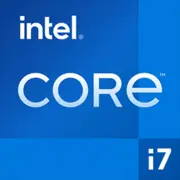Intel Core i7-6700HQ

Intel Core i7-6700HQ in 2025: Is It Worth Considering an Outdated Processor?
Analysis of Architecture, Performance, and Relevance for Modern Tasks
Architecture and Process Technology: The Skylake Legacy
The Intel Core i7-6700HQ processor, released in 2015, is part of Intel's sixth generation (codename Skylake). Despite its age, its architecture is still found in used laptops today.
Key Specifications
- Process Technology: 14 nm — for 2025, this is an outdated standard, but at the time, it provided a balance between performance and energy efficiency.
- Cores and Threads: 4 cores, 8 threads thanks to Hyper-Threading. Base clock speed is 2.6 GHz, with a maximum in turbo mode of 3.5 GHz.
- Integrated Graphics: Intel HD Graphics 530 with 24 execution units (EU), clocked up to 1050 MHz. Supports DirectX 12 and can output 4K (60 Hz via DisplayPort).
Skylake Features:
- Improved IPC (instructions per cycle) of 5-10% compared to the previous Broadwell generation.
- Support for DDR4-2133 MHz and LPDDR3 — relevant for upgrading older laptops.
- Enhanced virtualization and hardware encryption capabilities (Intel AES-NI).
Power Consumption and TDP: A Balance Between Power and Heat
With a TDP of 45 watts, the i7-6700HQ is classified as a processor for mid-range performance laptops. In 2025, this figure seems excessive compared to modern chips (e.g., Intel Core 12th generation with a TDP of 28 watts or Apple M3).
What Does This Mean for the User?
- Cooling Demands: Laptops with this CPU often come equipped with large heatsinks and noisy fans.
- Limitations in Thin Cases: In ultrabooks from 2016-2018, the i7-6700HQ could throttle (reduce clock speeds) due to overheating.
Performance: How Does It Handle Tasks in 2025?
A Geekbench 6 score (1082 / 3395) shows that the processor lags behind even budget modern models. For instance, the Intel Core i3-1315U (2023) scores around ~1800/5500.
Real-World Scenarios
1. Office Work:
- Browsing with 10+ tabs open, Word, Excel — no issues, but there may be slowdowns when working with PDF editors concurrently.
- Recommended at least 16 GB RAM and an SSD.
2. Multimedia:
- Video conversion in HandBrake (1080p to 720p): ~40-50% slower than the Ryzen 5 7640HS (2024).
- 4K video playback: manageable, but only with hardware acceleration (e.g., VLC with DXVA enabled).
3. Gaming:
- With integrated graphics: CS:GO — 40-60 FPS (720p, low settings), GTA V — 25-30 FPS (720p).
- With a discrete GPU like NVIDIA GTX 1650: Fortnite — 60 FPS (1080p, medium settings), but there may be bottlenecks due to the CPU in modern games (e.g., Cyberpunk 2077).
Turbo Boost Mode:
The processor can temporarily boost to 3.5 GHz, but under prolonged loads (rendering, gaming), it often drops to 2.8-3.0 GHz due to overheating.
Use Cases: Who Is It Suitable for in 2025?
- Students: For studying, document work, and Zoom calls.
- Office Workers: If heavy applications (e.g., AutoCAD) aren’t required.
- Budget Enthusiasts: For upgrading an old laptop (replacing HDD with SSD, adding RAM).
- Retro Gamers: Running games from the 2010s (Skyrim, Dota 2) with a discrete graphics card.
Not Suitable For:
- Modern gaming streaming.
- Working with neural networks or 3D modeling.
- 4K video editing.
Battery Life: How Long Will the Laptop Last?
The average battery life of a laptop with the i7-6700HQ is around 4-6 hours (with a 50-60 Wh battery). In power-saving mode (disabling Turbo, reducing brightness), it can stretch to 7 hours.
Energy-Saving Technologies:
- Intel Speed Shift: Dynamic frequency control (enabled by default).
- C-States: Putting cores into "sleep mode" during idle.
Tip: Replace the old battery (if the laptop supports replacement) — this can extend battery life by 1-2 hours.
Comparison with Competitors: What the Market Offers in 2025?
1. AMD Ryzen 5 7640HS (2024): 6 cores / 12 threads, TDP 35 watts, Zen 4. Twice the performance in multi-threaded tasks.
2. Apple M3 (2023): 8-core CPU, integrated graphics comparable to GTX 1050. Full autonomy of MacBook Air — up to 18 hours.
3. Intel Core i5-1340P (2023): 12 cores (4P + 8E), TDP 28 watts. Best energy efficiency and support for PCIe 5.0.
Conclusion: The i7-6700HQ falls behind even budget newcomers from 2023-2024, but it is cheaper in the second-hand market.
Pros and Cons
Strengths:
- Low cost (laptops from $200 on the second-hand market).
- Upgrade support: Replacing SSD and RAM extends the device's life.
- Reliability: Proven architecture over time.
Weaknesses:
- High power consumption.
- No support for modern standards: PCIe 4.0, Thunderbolt 4, Wi-Fi 6.
- Weak integrated graphics.
Recommendations for Choosing a Laptop
If you decide to buy a device with the i7-6700HQ in 2025, consider:
1. Form Factor:
- Gaming Laptops (e.g., old MSI GP62 models): Good cooling, discrete graphics.
- Business Models (Dell Latitude 5570): High repairability.
2. Configuration:
- Must have SSD (minimum 256 GB) and 16 GB RAM.
- Presence of a discrete GPU (GTX 1050 or better).
3. Battery Condition: Check charge cycles using utilities like HWMonitor.
Prices: There are no new laptops with this CPU anymore. In the second-hand market, prices range from $200-400 depending on condition.
Final Verdict: Who Is the i7-6700HQ Suitable For?
This processor is an option for those who:
- Are looking for a cheap laptop for basic tasks (up to $300).
- Are willing to accept performance limitations.
- Plan to use the device as a temporary solution.
Key Benefits:
- Cost savings.
- Upgrade potential.
- Sufficient power for Windows 10 / Linux.
However, if your budget allows spending $600-800, it is better to choose a laptop with a processor from 2023-2024 — this will provide a performance margin for the next 3-5 years.
Basic
CPU Specifications
Memory Specifications
GPU Specifications
Miscellaneous
Benchmarks
Compared to Other CPU
Share in social media
Or Link To Us
<a href="https://cputronic.com/cpu/intel-core-i7-6700hq" target="_blank">Intel Core i7-6700HQ</a>